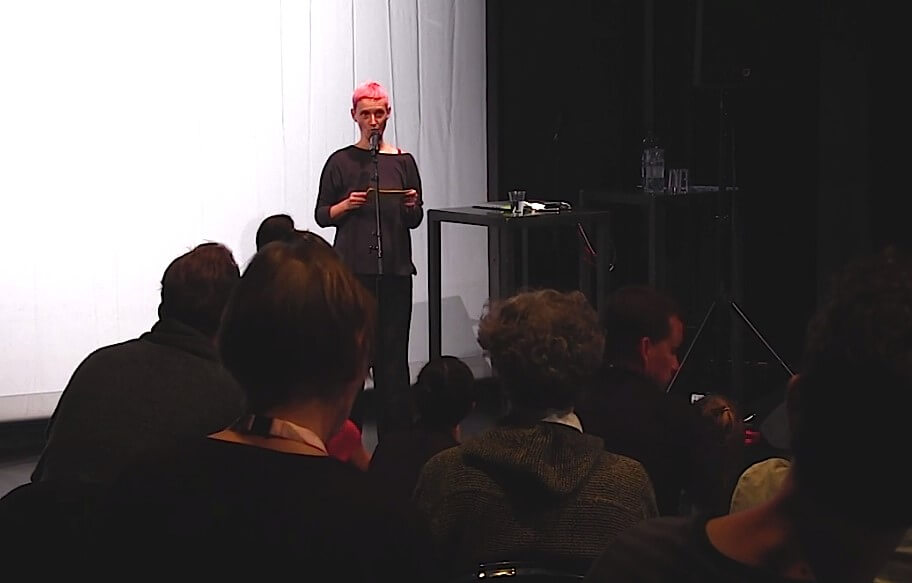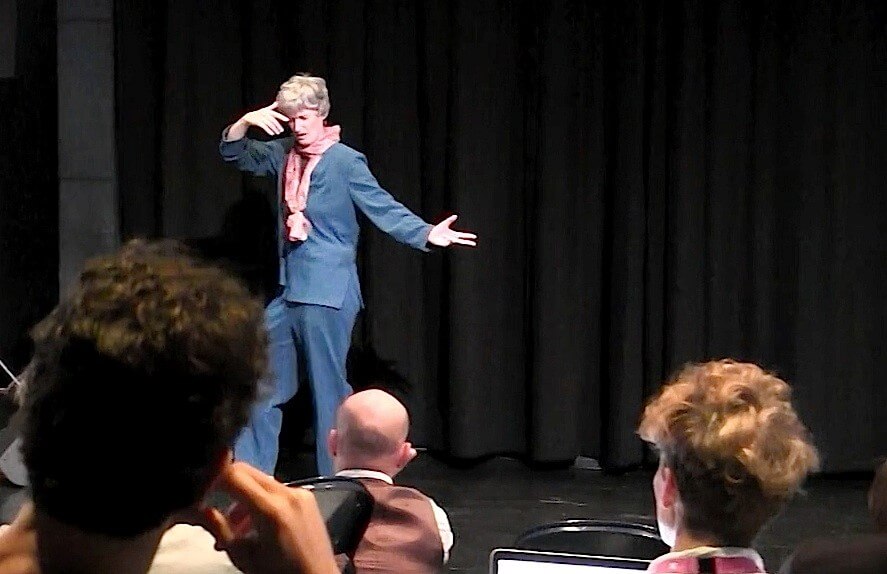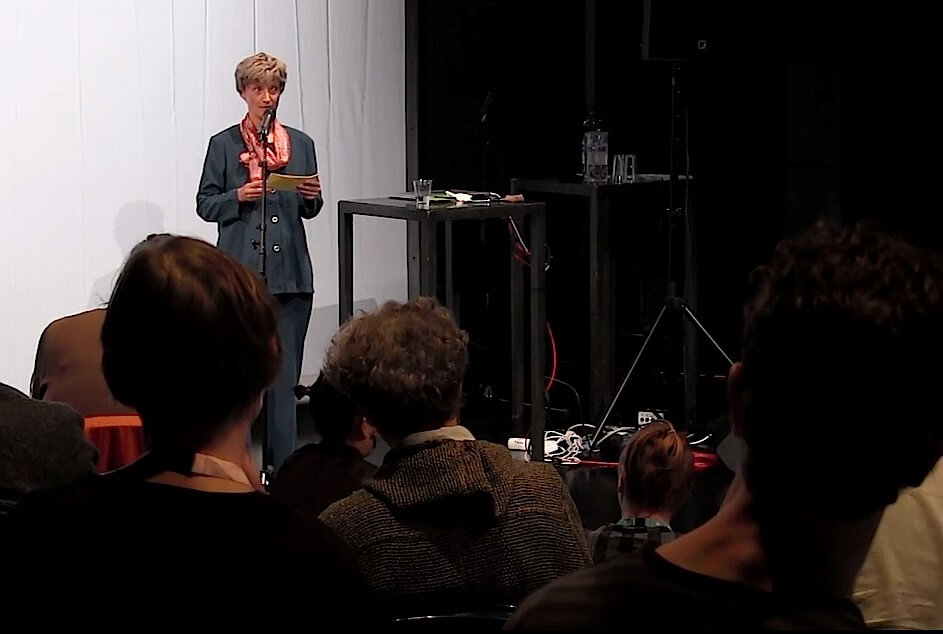Susanne Martin Searching for the Fountain of Age: Script of a Danced Lecture
Susanne Martin Searching for the Fountain of Age: Script of a Danced Lecture
Prelude
The lecture happens in a multifunctional and multidirectional space, well equipped with screens for projections, microphones, and speaker’s desks in two corners. While people come in, find their seats, and have their last verbal exchanges I start moving, crawling, tentatively start dancing between and around these two presentation zones. The moment the audience is settled and attends more clearly to my moving I increase the ’volume’ of my dancing. For the following two minutes I dance into all visible and accessible areas of the space in front of my audience, and by doing so I claim all that space to be my dance stage.
The Fountain of Knowledge
I take my place in one of the prepared presentation corners and use the microphone for the spoken part of my lecture.
To get the fountain of age going I think it is helpful to dive into some other, smaller fountains first, like the fountain of knowledge and the fountain of experience. So let’s start with the fountain of knowledge: My name is Susanne Martin, I’m a dancer who makes pieces, I’m a choreographer who improvises, I’m an improviser, who lately finished her PhD research called Dancing Age(ing). Dancing Age(ing), by now, is a book that stands here in your library. It’s also an extensive video collection and two live performances called The Fountain of Youth and The Fountain of Age (excerpts of the performances can be accessed here: vimeo.com/130871033; vimeo.com/142264906). All of that together questions:
- What is the potential of dance to intervene into our age(ing) culture?
- What does dance have to offer in terms of alternative ways of doing age(ing) and representing age(ing)?
What do I mean by alternative? Alternative to what? What is our age(ing) culture? I answer that briefly through age theory, a field that critically questions the cultural narratives, images, policies and concepts we have of human age(ing). Age studies question the meanings that we give to age and the process of age(ing). What critical age theory brings to the fore and problematizes are a range of cultural constructs, linear, oversimplified concepts of a life course, like that of progress-peak-decline decline decline … It brings to the fore an oversimplified dualism of youth as potentiality and hope on the one side. On the other side, there is age as either misery and loss or seniority and calm wisdom. Age theorists analyse how a deep-rooted ageism works quite similar to sexism or racism. Studying age(ing) critically helps to recognise the increasing tension between the fact that we, in post-industrial societies, get older and older, while, at the same time, the need to compete keeps increasing. The demand to stay young and peak performing and perfectly functioning keeps increasing. In other words, we live in a youth oriented culture, and dance has a strong tradition in participating in that by celebrating youth and youthfulness. I asked: what has dance to offer in regard to that?
In Dancing Age(ing) I looked at two interesting territories to answer that question:
- Improvisation practice and practitioners: I filtered specific strategies in the field of improvisation that support a lifelong physical creative practice, which also means to do and possibly think age(ing) differently. I looked at colleagues of mine, at their doing, thinking and practices as expert improvisers, and I also looked at my own improvisation practice.
- Performance: By that I mean these moments of showing dance in public. I found specific strategies of giving other images, imaginations, and representations of age(ing) to an audience. I looked at a range of current dance works and also created myself two more age performances, The Fountain of Youth and The Fountain of Age.
Maybe this is enough information for now. The book is there, it won’t run away, and the content might stay interesting for a while. (The opening chapter of Dancing Age(ing) can be accessed here .) Because, I guess, thinking about age(ing) is not a fleeting fashion. Because, as Kathleen Woodward so beautifully put it: “Age […] is the one difference we are all likely to live into” if we are lucky (Woodward 1999, x).
So, let’s leave the fountain of knowledge for now and turn to the fountain of experience and to the moment before I started to speak. I don’t know how much your experience of my moving was already coloured by the topic of age(ing) and by my abstract, which introduces my area of research in the conference schedule. For me, moving before speaking was about tuning, transitioning, about warming up to dance, to body, to my dance, and my body in your presence. I guess my warm up dance put us a little bit more on the same track in regard to what corner of contemporary dance making I represent and speak about, without the need for verbal labelling. Maybe it helped you to tune to the right channel – the one able to receive this particular body and this particular lecture.
The Fountain of Experience
Let’s have another bath in the fountain of experience.
I switch on music. “Yesterday When I Was Young” by Charles Aznavour is a melancholic song about lost youth and the passing of time. I change into an old ladies suit, put on a scarf, skin coloured nylon socks, and a grey wig. Together with the change of outfit I change my habitus. I show a lot of insecure, shy smiles and a less grounded and calmly balanced comportment. I start a kind of shaking warm up, then change my mind about the music and switch to Bob Dylan singing “Forever Young” because it’s “less heavy”. In the following five minutes I dance again into all areas of my already established stage. I oscillate between passionate dancing, engulfed into the music without any discernible skill or style, and short moments of insecurity, self-awareness, and discomfort. Around three minutes into this five-minute dance my attitude and dance repertoire shifts gradually towards a bit more articulate, differentiated movements and less outbursts of shame and insecurity. At the end of “Forever Young” I switch off the music and go back to the microphone.
The Fountain of Age
What I did just now is a current method of mine; it’s a very new method and still very much in development. I can describe it in two ways. I can call it ‘inviting my ghosts’. This particular ghost is called Claudia and came into being through a solo I made in 2004. When I now put that Claudia wig and costume on again – I can feel her everywhere in my body. I start by letting myself be moved by her and see what evolves from there. I try to figure out what I learn from having her around. As I made pieces about age(ing) and with a range of age(ing) protagonists since 2003, there are quite some ghosts that pass through me now if I call them.
I can describe it also in a more analytical way. Between 2003 and 2009 I made several pieces on age(ing), in which I worked rather theatrically. I developed older characters, imagined their biographies. They each had a specific style, their own way of dressing up, of being in the body, a specific muscle tone, a certain musicality, their very own way of dancing, their own music preferences. Actually, I was working on habitus and how biography gets inscribed in the body. And I let each of these characters collide with or break away from the normative script of their age biography. (For work on critically reflecting and rewriting one’s age autobiography see for example Gullette 2004.) In other words, I worked with the performativity of age(ing) and the intersection of age and gender performativity (see also Schwaiger 2012; Lipscomb & Marshall 2010: Woodward 2006). And now, many years later, it is interesting to me how easily I can make these different age and gender performances present again in my movements. The flowy, shy, but enthusiastic flexibility of Claudia, for example.
I learned a lot from Claudia. When creating her, I learned how disempowering it is to move in slippery nylon socks, and how energising it is to have a three-minute rock and roll freak out to a Julio Iglesias song. (Excerpts of the original piece can be accessed here: vimeo.com/158234066. The Claudia scene starts minute 4:53.) This is learning through experience. Later I learned to theorise the context, culture, and class specific fine distinctions between what is adequate and appropriate – what is inadequate and inappropriate for, let’s say, a petit bourgeois middle aged woman like Claudia. This is learning through studying writers like Miriam Haller (2013), Kathleen Woodward (1999), Pierre Bourdieu (1984), and Judith Butler (2004). Looking back, I would say that in 2004, as a 35 year old dancer, I deeply enjoyed to embody this older, slightly ridiculous amateur dance enthusiast, partly because it enabled me to break away from the ageist worries and normative expectations that characterise my little contemporary dance subculture.
To end my lecture (I take off the wig), rewind again: What was this second dance I did? My score for the dance was to first look for the typical Claudia way of moving, and then use that beginning, use Claudia’s love for dance, to just move on and dance on for some time. However, while I dance on I slowly, slowly let go of the typical Claudia moves and try to allow myself to just enjoy dancing to music. Because that is something I still did not manage to do for real, but that I want to do since years. Dancing to music, performing dance to music as a thing in itself. I guess something in me keeps saying that I’m too old to do that, or still too young.
Well, that is how my fountain of age looks like at the moment.
Thank you.
The images in this article are video stills from a recording of my danced lecture at CARPA 5.
Susanne Martin CARPA5 1.9.2017.
References
Bourdieu, Pierre. 1984. Distinction: A Social Critique of the Judgment of Taste. Cambridge: Harvard University Press.
Butler, Judith. 2004. Undoing Gender. New York: Routledge.
Gullette, Margaret Morganroth. 2004. Aged By Culture. Chicago: University of Chicago Press.
Haller, Miriam. 2013. “Ambivalente Subjektivationen: Performativitätstheoretische Perspektiven auf die Transformation von Alters- und Geschlechternormen im Geronto-Feministischen Diskurs.” In Alterswelt und Institutionelle Strukturen, editors M. Haller, H. Meyer-Wolters & F. Schulz-Nieswandt, 19–36. Würzburg: Königshausen & Neumann.
Lipscomb, Valerie Barnes & Marshall, Leni, eds. 2010. Staging Age: The Performance of Age in Theatre, Dance, and Film. New York: Palgrave Macmillan.
Schwaiger, Elisabeth. 2012. Ageing, Gender, Embodiment and Dance: Finding a Balance. New York: Palgrave Macmillan.
Woodward, Kathleen. 2006. “Performing Age, Performing Gender.” Feminist Formations 18 (1): 162–189.
Woodward, Kathleen, ed. 1999. Figuring Age: Women, Bodies, Generations. Bloomington: Indiana University Press.
Biography
Susanne Martin is a Berlin-based choreographer, performer, researcher, and teacher in the field of contemporary dance and theatre. She presents her work internationally in solo performances and collaborative stage works. Her research and artistic practice focuses on improvisation as a crucial practice within contemporary dance, narrations of the aging body, humour and irony in dance, and performance as research. 2017 she published Dancing Age(ing): Rethinking Age(ing) in and through Improvisation Practice and Performance, and her piece Von der Schönheit und Seltsamkeit des Anlehnens, co-choreographed with Eliane Hutmacher, won the German national competition Tanztreffen der Jugend. Susanne studied dance at Codarts University of the Arts Rotterdam, Folkwang University Essen, holds an MA from Inter-University Centre Dance Berlin, and a PhD from Middlesex University London. www.susannemartin.de.





